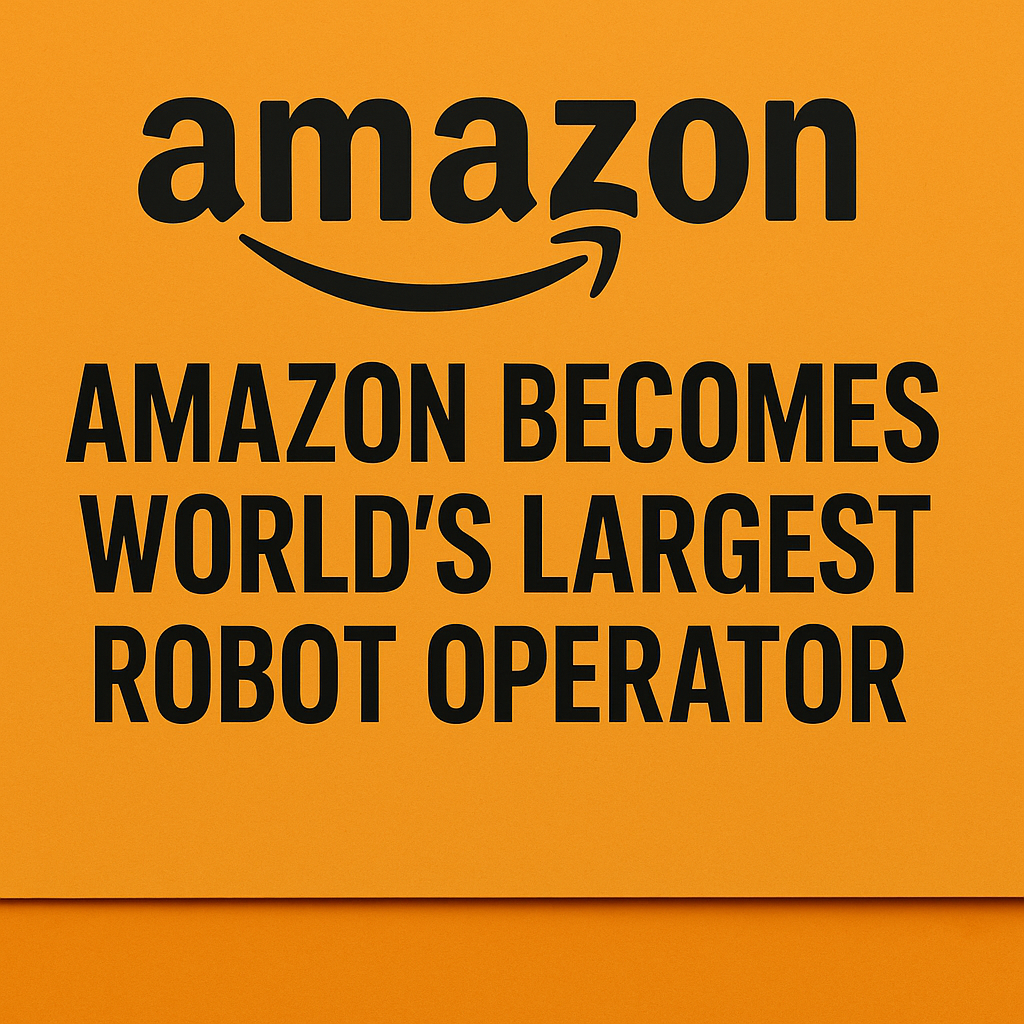🤖 The Rise of the Robots: Amazon Becomes World’s Largest Robot Operator
In a bold leap into the future, Amazon becomes the world’s largest robot operator by deploying over one million robots across its fulfilment centres. With the launch of its new generative AI model, DeepFleet, Amazon is not just rewriting logistics but reshaping the future of how people and machines work together.
This milestone is more than just a headline—it’s a signal that automation is no longer a concept from sci-fi movies. It’s here, and it’s scaling fast.
🔍 What’s Behind Amazon’s Big Robot Milestone?
Let’s rewind for a second.
Amazon began integrating robots into its operations back in 2012 after acquiring Kiva Systems. Back then, robots mainly shuttled inventory shelves around warehouses. Fast forward to today, and these machines have become stronger, smarter, and deeply integrated into Amazon’s daily grind.
Recently, Amazon announced the deployment of its millionth robot—a powerful feat considering it’s now running a robot fleet across more than 300 global facilities. According to Scott Dresser, Vice President of Amazon Robotics, this makes Amazon the world’s largest manufacturer and operator of mobile robotics.
That’s right—Amazon becomes the world’s largest robot operator, and it’s not stopping there.
🤯 What is DeepFleet and Why Is It a Game-Changer?
Now, let’s talk about the new buzzword: DeepFleet.
DeepFleet is Amazon’s in-house generative AI model designed specifically to optimise robot fleet operations. In plain English? It’s a system that tells robots how to move smarter inside Amazon’s giant warehouses.
Here’s what it does:
- Reduces robot travel time by up to 10%
- Minimises collisions and delays
- Improves package delivery speeds
- Enhances overall cost efficiency
And when you’re delivering millions of packages a day, 10% faster means a lot.
DeepFleet is not just about faster packages—it’s about creating an AI-powered robotic ecosystem where thousands of machines work in harmony.
🧠 Robots Aren’t Replacing Everyone—Yet
So here’s the million-dollar question:
If Amazon becomes the world’s largest robot operator, what happens to human jobs?
It’s a valid concern. And Amazon knows it.
In a recent interview, Amazon CEO Andy Jassy admitted that the company’s push toward generative AI and automation will mean that “fewer people will do the jobs the technology starts to automate.”
That’s a polite way of saying some roles might disappear.
But the story isn’t all grim. Amazon insists that robots are designed to work alongside humans, not replace them. Scott Dresser says robots take over the dull, heavy, and repetitive tasks, while employees are being trained for higher-skilled technical roles.
A great example is Amazon’s fulfilment centre in Shreveport, Louisiana, which reportedly hired 30% more staff in roles like:
- Maintenance
- Reliability engineering
- Robotics management
So yes, automation might reduce some jobs, but it’s also creating new ones in areas that didn’t exist before.
📊 Table of Contents
- Amazon’s Robotic Journey So Far
- What Is DeepFleet AI?
- How Automation Affects Jobs
- What Makes Amazon the World’s Largest Robot Operator?
- The Future: AI, Robots, and Human Collaboration
- Final Thoughts
📦 Why Amazon Becomes the World’s Largest Robot Operator Now?
It’s not just about being first—it’s about being fastest and most efficient.
Here’s why Amazon’s timing makes sense:
- Rising labour costs post-pandemic
- Global demand for quicker delivery (thanks to same-day/1-day delivery models)
- Advancements in generative AI
- Competition with companies like Tesla and Alibaba, which are also exploring humanoid robots
Simply put, automation is no longer optional for giants like Amazon. It’s survival of the fastest.
And in that race, Amazon just stepped into the lead.
🛠️ Not Just Mobile Robots—The Tech Is Expanding
Amazon’s robots aren’t just rolling around. The company has also developed:
- Proteus – an autonomous mobile robot that navigates freely
- Cardinal – a robotic arm that can sort packages
- Ernie – a robot that removes items from shelves
Some of these can lift up to 1,250 pounds! That’s like bench-pressing a whole vending machine.
With DeepFleet powering all of this, Amazon becomes the world’s largest robot operator with one of the most advanced AI-robotic integrations in the logistics industry.
🌐 External Perspectives on Automation
While Amazon makes headlines, it’s not alone in this journey.
Tesla, for instance, is planning to deploy humanoid robots in their factories by year-end.
Alibaba is also investing heavily in warehouse automation in China.
But what sets Amazon apart is its scale and AI integration, which puts it light-years ahead in logistics tech.
Read CNBC’s report on Amazon’s automation strategy →
💼 Will My Job Be Safe?
Let’s be real: automation is a double-edged sword.
On one hand:
- It reduces burnout and repetitive stress injuries
- It increases output and lowers operational costs
On the other hand:
- It does reduce low-skill job demand
- It requires constant upskilling
Amazon says it’s investing in training programs, but the reality is clear: some roles will fade away, others will evolve.
If you’re in logistics, maintenance, software, or robotics, this could be a great time to skill up.
🧩 Final Thoughts: What Does This Mean for the Future?
Whether you’re excited or anxious, one thing is certain—the future of work is changing fast.
With Amazon becoming the world’s largest robot operator, we’re witnessing a shift where AI and robots aren’t just tools—they’re co-workers.
For consumers, that means faster deliveries and lower costs.
For workers, that means a chance to adapt, upskill, and step into new roles that only exist because of this tech revolution.
So, is this the end of jobs as we know them? Not really.
But it might just be the beginning of a new way to work—one where humans and machines team up to do more, faster, and smarter than ever before.

